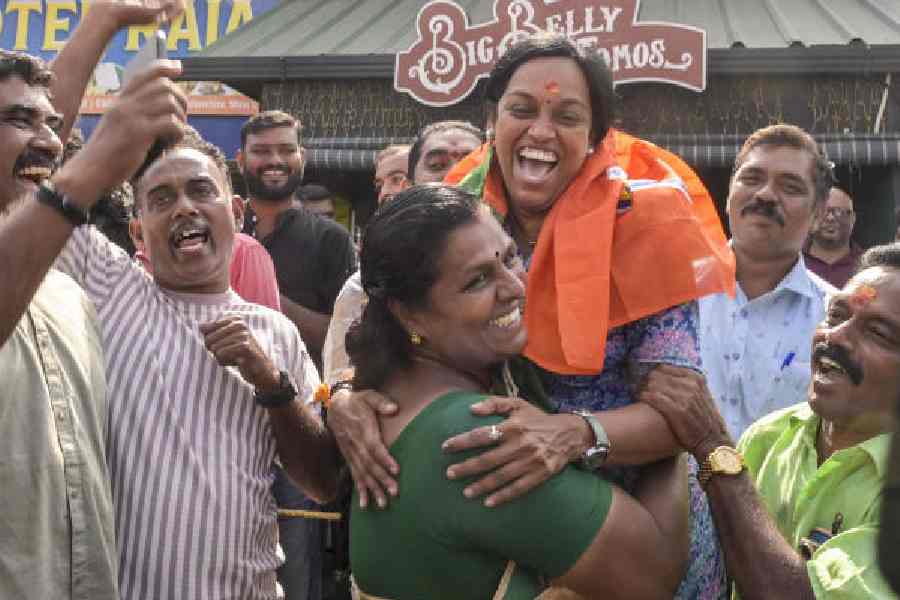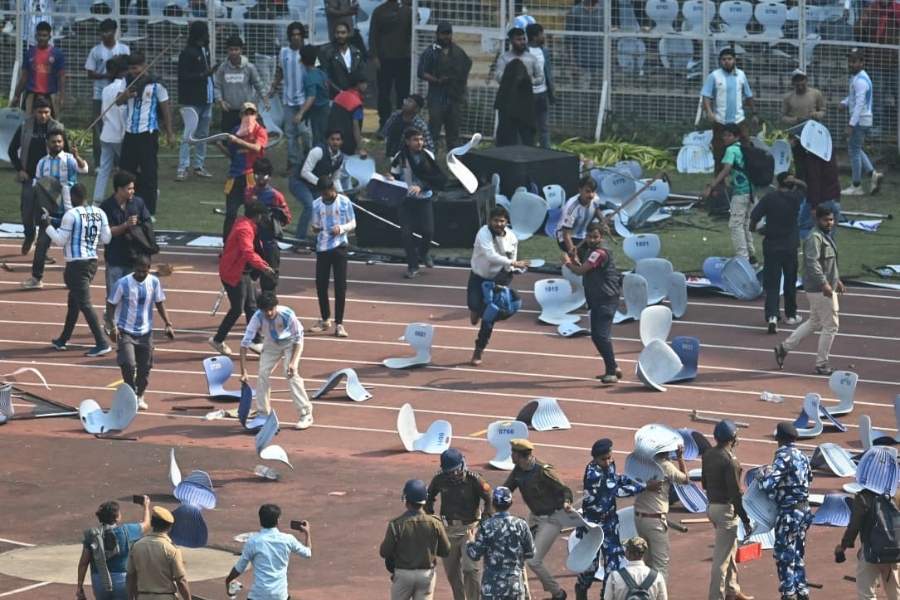‘The woman with class’. Considering that Bengali cinema of the 1950s and ’60s had women of the stature of Suchitra Sen, Supriya Devi, Sabitri Devi, Sandhya Ray and Madhabi Mukherjee, to name only a few, it is no mean compliment. In that roster of luminaries, Arundhati Devi stood out not only with her majestic demeanour and aristocratic appearance but also with her diverse range of accomplishments. Unlike the others I mention here, Arundhati Devi was not just an actor par excellence, she was a producer, she directed five films, two of which won national awards, a composer, a singer and a dancer (both of which she excelled at), and was also skilled as a painter so much so that at one time she even considered pursuing art as a career given that Kala Bhavan under the tutelage of Nandalal Bose was bustling with creativity at the time.
Singing for Gurudev
A late summer afternoon. As the heat of the day settles on the branches of a chhatim tree, an intoxicating fragrance wafts on the breeze. Rabindranath Tagore sits under the tree. Facing him, a 12-year-old girl who has arrived from Dhaka to learn Rabindrasangeet in Santiniketan. The poet is conducting the entrance test himself. The girl sings ‘Ujaad koray loho hey amaar ja kichhu sombol’. Tagore finds himself humming along. Then asks her to sing another song.
When she is done singing the second song, Tagore asks for one more. She remains silent for a while, then says that ‘Shailaja-da’ (Shailajaranjan Majumdar) taught her only those two songs that afternoon, she does not know any more. Rabindranath is impressed that a girl this young has mastered two songs in one afternoon! He laughs and says he is sure she will do well as a singer. He is however doubtful if she will stay on at the ashram. He laments that many girls come to Santiniketan. They learn to sing and then one day they leave. He wonders if she will leave too.
The girl was Arundhati Devi. And though she did make it as an accomplished singer as predicted by Gurudev, she did leave Santiniketan. Music remained a passion, something she sought refuge in often. However, much like the sequence in one of her lesser-known films, Sushil Majumdar’s Pushpadhanu (1959), where Shantanu (Uttam Kumar), when requested to play the flute to Arundhati Devi’s dance, replies, ‘I cannot turn my intoxication into a profession,’ she too did not let music become a profession.
In an interview, she said as much, ‘Music is not my profession; for me it is the joy-filled sky. And for this, I am grateful to the creator. When art becomes a livelihood, many trivial matters get entangled with it, forcing even the artist to behave unartistically. If Rabindrasangeet had become my livelihood, perhaps I would have been compelled to do things under various pressures and circumstances that would have been un-Rabindranath-like. Today, when I see everything with such a clear perspective, without any bias or hatred towards anyone, it’s because Rabindrasangeet is not my profession. And that’s why no artist is my adversary. Everyone is my friend.’
Tutelage at Santiniketan
Arundhati was born into the scholarly Guhathakurta family of Dhaka. She had 17 siblings, each incredibly talented. Arundhati’s father, Bibhucharan Guhathakurta, was an enlightened soul with a philosophical bent of mind. Arundhati and her siblings grew up in a nurturing and progressive environment. Her maternal uncle and aunt were avid admirers of Tagore and were instrumental in bringing Arundhati to Santiniketan, where she learned music under Shailajaranjan Mukherjee, and in the company of Kanika Bandopadhyay and Suchitra Mitra.
In 1942, Indira Devi Chaudhurani and Pramatha Chaudhuri began their permanent residence at Santiniketan. Indira Devi, known as ‘Bibi-di’, was, according to Shailajaranjan, ‘a treasure trove of songs’. In an interview, Arundhati spoke about her debt to Indira Devi, ‘I learned songs from Bhanu Singher Padavali, Mayar Khela and many other plays from Bibi-di. Whenever there was an off-period, I would rush to Uttarayan. Bibi-di might have been sitting down to eat or cooking something. When she saw me, she would say, “There’s a pencil and paper on that table. Take down the notations.” As enthusiastic as we were about learning, she seemed even more eager to guide us.’
Arundhati also learned dance from Guru Brajabashi and Balakrishna Menon. She performed the dance drama Mayar Khela with Kanika, with Tagore attending rehearsals and singing at these. Arundhati portrayed Shanta, while Kanika played the role of Pramada. Indira Devi played the piano. Arundhati used to be mesmerised listening to Tagore singing, even though she was primarily focused on Shanta’s role. As soon as the rehearsals ended, she would collect the songs and their notations from Indira Devi. Over a period of three years she mastered 600 songs.
A stint at All India Radio and singing for Gandhi
In 1940, Arundhati received an invitation from All India Radio to sing Rabindrasangeet, but her mother objected on the ground that the honorarium AIR insisted on paying, a princely Rs 5 for each performance, was akin to selling music. It was Shailajaranjan who goaded her to take up the assignment. He argued that it was a means to ensure a larger reach for Rabindrasangeet. Thus began her journey of singing on the radio. However, she did not stop at simply singing. To enlarge the reach of Rabindrasangeet, she also started translating the songs. Those translations became popular and eventually reached Gandhi’s ears too. The Mahatma, breaking one of his innumerable fasts at the time, insisted on listening to Arundhati’s rendition of ‘Jodi tor daak shuney’ and ‘Amaay kshomo hey kshomo’. Later, she would even sing Rabindrasangeet in her films.
All said and done, a career as a singer seemed hers for the taking. In an interview, Shailajaranjan said with a tinge of regret, ‘If she had just focused on singing, my two students would have shared the same seat.’ At Visva-Bharati, Kanika Bandopadhyay and Arundhati Devi were known as Mohor and Nuku, respectively. When the exam results were announced, Nuku secured the first position, and Mohor the second. Kanika eventually came to be regarded as one of the finest exponents of Rabindrasangeet.
The call of cinema
Fate, and probably Arundhati herself, willed otherwise. The multitalented young girl found her identity as an actor in films.
Her debut feature, Mahaprasthaner Pathe (1952), gave an inkling of the trajectory she would carve out for herself as an actor. As Mrinalini Vasudevan says in her essay ‘Remembering Arundhati Devi on Her Birth Centenary’ in Critical Collective, ‘Amidst the traditional crowd of pilgrims making their way to Kedarnath and Badrinath in Kartick Chattopadhyay’s [film], a young woman on horseback stands out. Dressed in a white sari in a smart long coat, she is vivacious and adventurous, despite being a widow. In the course of the journey, she sneaks aside to reveal to the main protagonist (a potential romantic interest) that the pilgrimage has given her a fresh chance to rediscover agency, independence and maybe even love.’
Agency. That word is operative in the choices she made as an actor. In a career spanning barely a handful of films, she played characters who were independent-minded and, in a departure for the times, working women.
Chalachal (1956), directed by Asit Sen, is a prime example. The film stars Arundhati Devi as Neela, a surgeon who befriends the terminally ill painter Avinash (Nirmal Kumar) and is influenced by him to marry businessman Bipin (Asit Baran) with tragic consequences all round. It is rather revolutionary for a film made in the mid-1950s to have a woman as surgeon and the actor makes it believable right through. Its remake, Safar (1972), suffered with Rajesh Khanna stepping in to play Avinash and the focus shifting from Neela. Chalachal is all the way an Arundhati Devi vehicle, with the actor at the peak of her imperious histrionic best, juggling the demands of her professional and personal life.
It is this ‘imperious’ note she brings to her characters that makes her just right in a film like Tapan Sinha’s Jhinder Bondi (1961), where she imbues her character Rani Kasturi Bai with enough heft despite being cast against heavyweights like Uttam Kumar (in a double role) and Soumitra Chatterjee (in what turned out to be a career-defining role for him).
Challenging stereotypes
Not only did she offer variety and steered clear of what I often lament as the ‘nyaka’ (untranslatable, but approximating affected, contrived) histrionics of the leading ladies of the era, the roles she essayed challenged conventional mindsets pertaining to caste, religion, marriage and morality.
In Kalamati (1958), she is the manager of a crèche for children of working tribal women. She is the slave girl who falls in love with a prince in Tapan Sinha’s Kshudita Pashan (1960), the dancer in Pushpadhanu where she initially rejects motherhood, and a teacher in Manmoyee Girls School (1958). As Sister Nivedita, in what is regarded as one of her most successful films, Bhagini Nivedita (1962), she is characteristically brilliant (it is impossible not to be moved when she says, ‘I am not a foreigner… like your daughters, I am also a daughter of this country. The soil of this country is my mother, the lord of this country is my lord’). However, the film, despite winning the National Award for best film, is of dubious historical value and offers little objective light on Sister Nivedita, which is not surprising given the regard with which she is held.
It is, however, Tapan Sinha’s Jatugriha (1964) that can be regarded as her crowning glory as an actor. Here she was paired opposite an Uttam Kumar at the top of his game, but like in her other films with the mahanayak – Bicharak and Jhinder Bondi in particular, but also in their first film together Bokul, where she easily outshone him, and in films like Pushpadhanu and Shiulibadi (directed by Pijush Bose from a story by Tapan Sinha) – she stood her ground.
In fact, Uttam Kumar is on record as saying that whenever cast opposite Arundhati Devi, he had to prepare better for his role. Unlike with his more regular co-stars Suchitra Sen and Supriya Devi, who were cast in more conventional roles with Uttam Kumar, Arundhati Devi challenged him intellectually and it reflected in his performances.
Of these, Jatugriha stands out. Released in the year that Satyajit Ray made waves internationally with Charulata, Tapan Sinha’s tale of marital discord has somewhat fallen off the radar. However, for the discerning viewer there’s a lot to the film, including one of the most trenchant narratives of two people falling out of love. As Madhuri, whose life with her husband Shatadal (Uttam Kumar) is coming apart, Arundhati is a picture of dignity and strength. She has internalised the era’s conditioning of motherhood being a woman’s greatest purpose in life, with the result that her infertility creates an ever-expanding schism with her husband. Though Shatadal seems to have accepted the situation, she is never able to.
The film’s opening sequences showing the couple back home after a day at work, going about their mundane chores, and barely able to have a conversation (he even walks out to catch a film on his own) are as good as any of the era’s many Bengali classics. And though the film’s narrative gives us more of Shatadal’s side of the story, what we see of Madhuri (including her insistence on the divorce) is telling because of what Arundhati brings to her character. And when they meet at a train station years later, the way she attends to him and yet tells him why she could never remarry – ‘What I couldn’t give you, I wouldn’t be able to give any other man as well. Knowing that, there is no point in getting entangled with another life’ – is heart-breaking primarily because of what you have learnt of the woman: here is someone who has not understood that marriage can be based on companionship without the trappings imposed by gender stereotypes.
A producer and director with an eye for a good story
If her choice of films as an actor and the roles she portrayed made her stand out in an industry brimming with charismatic stars and brilliant actors, what really set her apart were her forays into filmmaking. Though Kanan Devi had blazed a trail as an actor, singer and then producer in the 1930s and ’40s, none of Arundhati Devi’s contemporaries branched out to embrace other aspects of cinema.
Arundhati Devi established her credentials as a producer with an eye for a good story with her maiden venture as producer, Bicharak, directed by Prabhat Mukherjee (Arundhati Devi’s husband at the time). Based on a story by Tarashankar Bandopadhyay, this is one of the early films, along with Marutirthe Hinglaj, that showed Uttam’s willingness to experiment with non-heroic roles. A complex character study of guilt, responsibility and redemption, Bicharak casts Uttam as a judge supremely confident of his ability to deliver justice, who comes face-to-face with an ethical crisis when asked to judge a case that has echoes from his past and a choice he had made. Even as he decides on the fate of the defendant, he has to confront his own moral culpability – and Uttam’s every gesture, his face often in close-ups, reveals the agony of his soul.
While Arundhati matches him step for step as his second wife Sarama, her character suffering similar pangs of guilt, and looking for redemption, it is in her choice of subject to produce as a film that demonstrates her willingness to go against the grain. Dealing with complicated issues – including themes of infidelity, whether marriage entails only duty and responsibility and if yes, is it okay to look for love outside its confines, and with the very slippery aspect of whether the film’s protagonist (Uttam Kumar) and by extension Sarama are guilty of the death of his suspicious and nagging first wife – this was by no means an audience-pleasing subject.
In director’s chair: Chhuti (1967), Megh O Roudro (1969), Deepar Prem (1983)
As a director, Arundhati Devi made five well-regarded films. It is unfortunate that only three of these are available to view. The actor’s son has gone on record asking for information on any available print of Padi Pishir Barmi Baksha, based on the classic story by Lila Majumdar. Her directorial ventures share a few common features. Almost without exception, these are adaptations of classic literary sources – Bimal Kar, Rabindranath and Tarashankar. They also depict the director’s affinity for children and young adolescents. Each of these three films have a budding love story between young people at its core. Chhuti and Megh O Roudro also provide glimpses of her eye for open landscapes (probably a tribute to her memories of Santiniketan) as she paints an evocative picture of a township in Bihar in the former and an idyllic village in the latter. What stands out in each are the ‘portrayal of familial voices, often marginalised in society, and their greater aspirations in mundane situations’. She also demonstrates a feel for understatement as also free-flowing dialogues in each of these films (she wrote the screenplays for these films).
Based on Bimal Kar’s serialised novel Khawrkhuto, Chhuti, set in a Christian community in Bihar, is an affecting tale of young love blossoming against the backdrop of a terminal illness afflicting one of the lovers. For those used to seeing overblown melodramas involving cancer patients in Hindi films (Anand, et al), Chhuti is like a breath of fresh air, with Nandini Maliya and Ajitesh Bandopadhyay putting in top-notch performances as the afflicted young girl Bhramar and her father respectively. Bhramar’s mother, a Hindu married to a Christian, passed away when she was still a child and her father remarried. Bhramar grows up a quiet woman, often given to melancholia and bouts of ill health. There’s also a marked frostiness between her and her disciplinarian stepmother. In Bhramar’s memories there’s just a hint of her mother being treated as an outcaste in the community because of her religion. Things take a turn for the better when a young man, Amal, comes on a vacation to recuperate from ill health. Love blooms and she takes to singing before tragedy strikes. What works for the film is its understated, elegiac telling and the way the director makes the sylvan landscape and the background music a part of its characters’ world views.
Produced by Ajitesh Bandopadhyay, who also stars in a small role in the film as a priest, Megh O Roudro tells the story of a young lawyer Shashibhushan (Swaroop Dutta) who returns to his village after getting his degree in law. A relationship develops between him and the young illiterate Giribala (Hashu Banerjee) who learns to read and write under his tutorship – though he remains impervious to her growing affection. Taking up cudgels in court on behalf of Giribala’s father who is insulted by the British administrator, he finds himself abandoned by the very people he seeks to defend. Unwilling to apologise to the British or compromise, he is imprisoned and spends years in jail. Meanwhile, Giribala is married off to a prosperous man. By the time Shashibhushan is released, Giribala is widowed, and she sends her vehicle to escort the man she has loved all her life, the man who gave her dignity and self-confidence, to her now palatial house. The director beautifully builds the world of a 19th-century village and its dramatis personae and again weaves in the surroundings and the music to tell her story.
Deepar Prem is different from Chhuti and Megh O Roudro in that it is set in the city (Kolkata). However, like the other films, this too has at its core a tender love story between two young people, on opposite ends of the social spectrum – a wilful woman from a privileged, well-to-do family, Deepa (Moon Moon Sen in probably the one good role of her career), and the grandson (played with understated pathos by Tapas Pal) of a woman who was once employed as a maid in Deepa’s house. Not as lyrical as the other two films in this list, and a bit too talky, there are enough flashes of the Arundhati of old in the issues she rakes up through the character of Deepa who leaves home one night to follow her heart.
Arundhati Devi doubled as a composer in all the films she directed, coming up with soundtracks that were immensely popular at the time and that have stood the test of time. In Chhuti, she composed the music for two songs, ‘Amaar haath dhore tumi’ and ‘Amaar jeevan nodir opare’, both sung by Pratima Bandopadhyay. Chinmoy Chattopadhyay and Pratima Bandopadhyay also sang the Rabindrasangeet ‘Ei lobhinu sango tabo’. Megh O Roudro featured Manna Dey singing ‘Na chahile jaare pawa jaaye’, composed by Arundhati Devi. Pratima Bandopadhyay and Probir Guhathakurta also sang in the film. Manjushree Chakraborty sang ‘Ke nibi phool’ and ‘Dayamoyee naamti maago’ in Padi Pishir Barmi Baksha, which also featured Satyendra Nath Datta’s ‘Palki chole gagan tolay’. In Deepar Prem, Arundhati Devi directed music for ‘Tomar khola hawa’ sung by Arundhati Homchowdhury, and ‘Jawto baar alo jalate chaai’ sung by Shreya Guhathakurta.
The face of a rapidly modernising woman
In their essay ‘Different Aspects of Cinema’ from the centenary book of cinema edited by Anil Choudhury, Nilacharya Acharya and Divyendu Palit elucidate Arundhati Devi’s significant role as a filmmaker by juxtaposing her work against other stalwarts, only three of whom are women. They write, ‘In cinema, various art forms such as literature, drama, acting, music, etc., merge to form a new entity… Some directors have enriched themselves with diverse knowledge in various art forms and become directors. Some directors from the literary field include Sailajananda, Premendra Mitra, Jyotirmoy Ray; from the theatre world, Sishir Bhaduri, Naresh Mitra, Uttam Kumar, Dilip Ray, Sukhen Das, and from the world of actresses, Arundhati Devi, Manju De, and Aparna Sen.’
Arundhati Devi was one of a kind. With her confident bearing, her fashion sense (equally at ease in gowns and anarkalis, before the term probably came into use, sari and short-sleeve blouse ensembles, and tennis dresses), her cerebral orientation and her willingness to experiment with different art forms, she was the face of a rapidly modernising woman of an independent nation, caught in the cusp of change.











